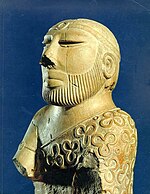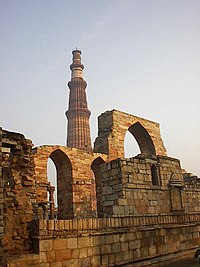
A set of some 26 lectures, each around 45-50 minutes in length, on the history of Indian civilization from antiquity to 1947, originally delivered by Vinay Lal as an undergraduate course at University of California LA in Winter 2012. Watch lectures >>>>
The history of the Indian subcontinent begins with evidence of human activity as long as 75,000 years ago, or with earlier hominids includ from about 500,000 years ago.
The Indus Valley Civilization, which spread and flourished in the northwestern part of the Indian subcontinent from c. 3300 to 1300 BCE in present-day Pakistan and northwest India, was the first major civilization in South Asia. A sophisticated and technologically advanced urban culture developed in the Mature Harappan period, from 2600 to 1900 BCE. This civilization collapsed at the start of the second millennium BCE and was later followed by the Iron Age Vedic Civilization, which extended over much of the Indo-Gangetic plain and which witness the rise of major polities known as the Mahajanapadas. In one of these kingdoms, Magadha, Mahavira and Gautama Buddha propagated their Shramanic philosophies during the fifth and sixth century BCE.
Most of the subcontinent was conquered by the Maurya Empire during the 4th and 3rd centuries BCE. Various parts of India were ruled by numerous Middle kingdoms for the next 1,500 years, among which the Gupta Empire stands out. This period, witnessing a Hindu religious and intellectual resurgence, is known as the classical or "Golden Age of India". During this period, aspects of Indian civilization, administration, culture, and religion (Hinduism and Buddhism) spread to much of Asia, while kingdoms in southern India had maritime business links with the Roman Empire from around 77 CE. During this period Indian cultural influence spread over many parts of Southeast Asia which led to the establishment of Indianized kingdoms in Southeast Asia.
7th-11th centuries saw the Tripartite struggle between the Pala Empire, Rashtrakuta Empire, and Gurjara Pratihara Empire centered on Kannauj. Southern India saw the rule of the Chalukya Empire, Chola Empire, Pallava Empire, Pandyan Empire, and Western Chalukya Empire. The Chola dynasty conquered southern India and successfully invaded parts of Southeast Asia and Sri Lanka in the 11th century. The early medieval period Indian mathematics influenced the development of mathematics and astronomy in the Arab world and the Hindu numerals were introduced.

Muslim rule started in some parts of north India in the 13th century when the Delhi Sultanate was established in 1206 CE by the central Asian Turks. [Though Muslims conquered Sindh to Multan in 711-12, by Umayeds, continued till establishment of Delhi Sultante]. The Delhi Sultanate ruled the major part of northern India in the early 14th century, but declined in the late 14th century, which saw the emergence of several powerful Hindu states like the Vijayanagara Empire, Gajapati Kingdom, Ahom Kingdom and Mewar dynasty.

In the 16th century Mughals came from Central Asia and covered most of India gradually. The Mughal Empire suffered a gradual decline in the early 18th century, which provided opportunities for the Maratha Empire, Sikh Empire and Mysore Kingdom to exercise control over large areas in the subcontinent.
Beginning in the late 18th century and over the next century, large areas of India were annexed by the British East India Company. Dissatisfaction with Company rule led to theIndian Rebellion of 1857, after which the British provinces of India were directly administered by the British Crown and witnessed a period of both rapid development of infrastructure and economic stagnation. During the first half of the 20th century, a nationwide struggle for independence was launched with the leading party involved being the Indian National Congress which was later joined by Muslim League as well.

The subcontinent gained independence from the United Kingdom in 1947, after the British provinces were partitioned into the dominions of India and Pakistan and the princely states all acceded to one of the new states. [Wikipedia]
* * * * * * * * * * * * * * * * * * *
Humanity, Religion, Culture, Ethics, Science, Spirituality & Peace
http://PeaceForumNet.blogspot.com
http://AftabKhan-net.blogspot.com
* * * * * * * * * * * * * * * * * * *...
http://AftabKhan-net.blogspot.com
* * * * * * * * * * * * * * * * * * *...
